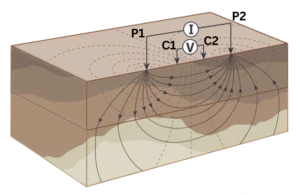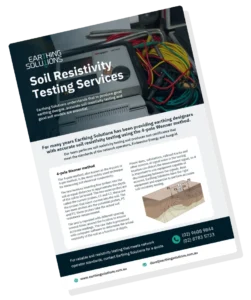Soil resistivity testing using the 4-pole Wenner method
Soil resistivity testing is a critical factor in electrical earthing design. Earthing Solutions understands that to produce good earthing designs, accurate soil resistivity testing and good soil models are essential. For many years we have been providing earthing designers with accurate soil resistivity testing using the 4-pole Wenner method.
 The 4-pole method, also known as the 4-point or 4-pin method, is the most widely used technique for measuring soil electrical conductivity. The test involves inserting four probes into the soil at equal distances to approximate the depth of the soil to be tested. The two outer probes are called the current probes, C1 and C2; these are the probes that inject current into the soil. The two inner probes are the potential probes, P1 and P2; these probes take the actual soil resistance measurement. The test is repeated with different spacing several times around the location to ensure accurate readings. The raw data is processed with computer software to determine the actual resistivity of the soil as a function of depth.
The 4-pole method, also known as the 4-point or 4-pin method, is the most widely used technique for measuring soil electrical conductivity. The test involves inserting four probes into the soil at equal distances to approximate the depth of the soil to be tested. The two outer probes are called the current probes, C1 and C2; these are the probes that inject current into the soil. The two inner probes are the potential probes, P1 and P2; these probes take the actual soil resistance measurement. The test is repeated with different spacing several times around the location to ensure accurate readings. The raw data is processed with computer software to determine the actual resistivity of the soil as a function of depth.
Power lines, substations, railroad tracks and other sources of signal noise in the testing location can distort the measurement signal, so it is important to use equipment that is capable of discriminating between the signals. Rest assured, Earthing Solutions have the right equipment and expertise to perform accurate soil resistivity testing.
Our team performs soil resistivity testing and produces test certificates that meet the standards of the network operators, Endeavour Energy and Ausgrid.

